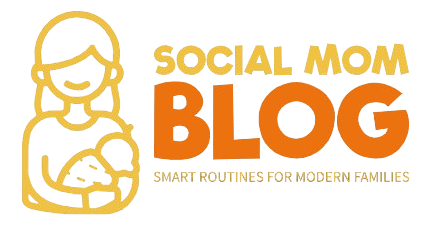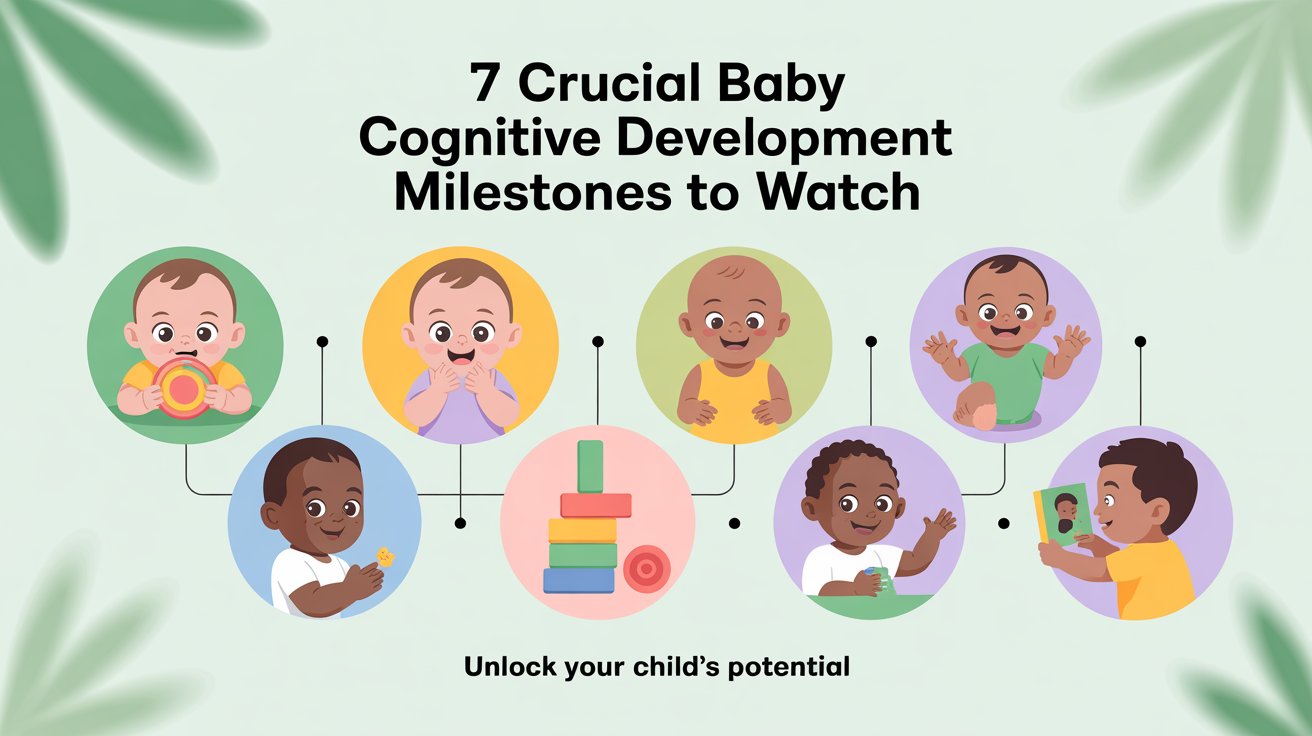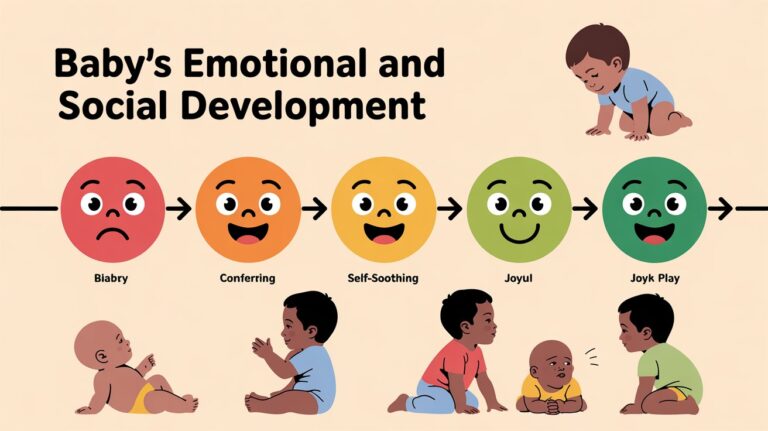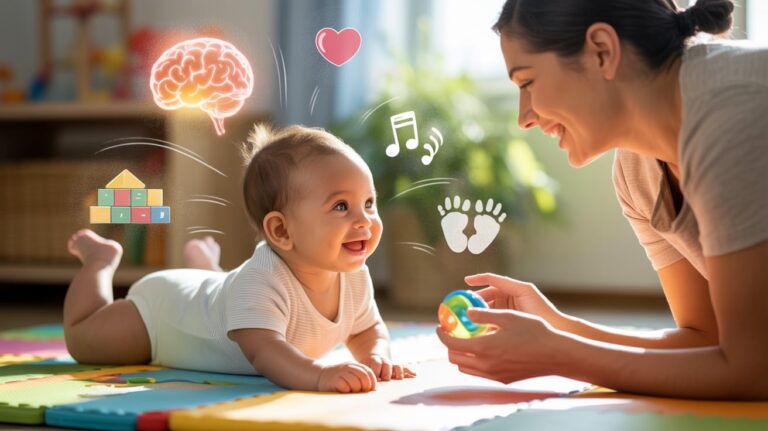7 Crucial Baby Cognitive Development Milestones to Watch
Ever wondered what is cognitive development and why it matters so much in your baby’s first years? Cognitive growth is one of the main pillars of infant development, shaping how babies think, learn, and make sense of the world. From recognizing faces to solving simple problems, these cognitive skills milestones mark steady progress in early learning.
Intellectual development in babies isn’t just about age; it’s about experiences, stimulation, and responsive caregiving. Through play, exploration, and everyday interactions, babies build memory, attention, and problem-solving abilities, the perceptual abilities in babies that prepare them for lifelong learning.
In this article, we’ll walk you through what baby cognitive development is, key milestones, red flags to watch for, and practical ways to nurture your little one’s growing mind.
What Is Baby Cognitive Development?
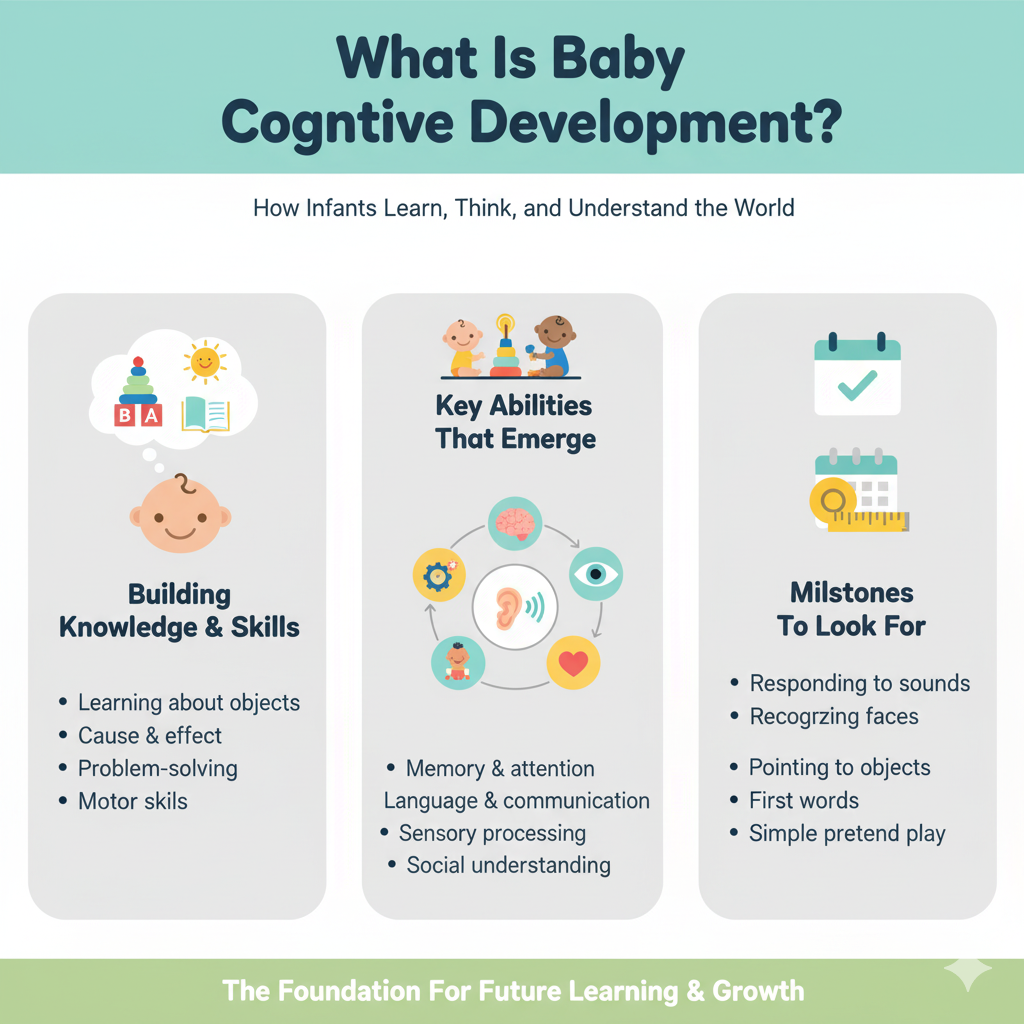
Baby cognitive development refers to the way infants learn, think, and make sense of the world. It’s the foundation of intellectual development in babies, shaping skills like memory, problem-solving, and decision-making. While emotional and physical growth focus on feelings and movement, cognitive growth is about the brain’s ability to process information and build understanding.
In the first years, babies begin to develop an attention span, start forming early memory development, and explore cause-and-effect understanding, such as realizing that shaking a rattle makes a sound. Much of this progress happens through sensory and exploration play. By touching, watching, and listening, babies connect experiences to knowledge.
Supporting this process isn’t about formal lessons but about daily interactions. Talking to your baby, letting them explore safe objects, and playing simple games all encourage their brain to build stronger connections. This makes cognitive development not only a scientific concept but also a very practical part of everyday parenting.
👉 For a full overview of how thinking skills fit into the bigger picture of growth, see our guide on Holistic Infant Development.
Why Baby Cognitive Development Matters in the First Years?
The first years of life are a time of extraordinary brain growth. By the age of five, a child’s brain reaches about 90% of its adult size, making this period a baby brain growth timeline parents cannot afford to overlook. Following a Feeding Chart for Newborns and Babies can support healthy synaptic development and long-term learning.
During these early years, millions of connections called synaptic connectivity are formed and strengthened through experience. This process, known as neuroplasticity, allows the brain to adapt and build the pathways that support learning, memory, and problem-solving.
What babies see, hear, and feel has a direct impact on how these connections develop. Simple forms of early brain stimulation, such as talking, singing, or letting a baby explore safe objects, can make a significant difference.
Responsive caregiving and sensory stimulation are not just enriching activities but biological necessities that lay the foundation for strong thinking skills. The strength of these early neural networks is linked to later abilities in executive function, emotional regulation, and academic performance.
In other words, nurturing cognitive growth in the first five years does more than prepare children for school; it builds the mental framework they will rely on for a lifetime of learning and resilience.
Healthy Cognitive Developmental Milestones
From Birth to Five Years
Cognitive milestones are the steppingstones of your child’s learning journey. They highlight how little ones begin to think, explore, remember, solve problems, and make sense of the world around them.
For centuries, babies were thought of as “mini adults” with limited awareness. It wasn’t until the groundbreaking work of psychologists like Jean Piaget that we discovered children don’t just think less than adults—they actually think differently. Modern research now shows that even newborns are active learners, constantly observing, experimenting, and adapting to their surroundings.
From the first coos and eye contact to asking endless “why” questions, cognitive development unfolds in fascinating ways. Below, we’ll walk through the key milestones from birth to age five, along with tips on how parents and caregivers can nurture a child’s growing mind.
Select an Age Group to View Cognitive Milestones
Birth to 3 Months: Discovering the World
The earliest months of life are full of discovery. Infants begin to connect their senses with the world and gain awareness of both their bodies and their environment.
By 3 months, most babies can:
- Show anticipatory behaviors like rooting or sucking when offered a bottle or breast
- Detect differences in sounds, such as changes in pitch or volume
- See objects more clearly at close range (up to 13 inches)
- Follow moving objects, especially caregiver faces
- Recognize the full spectrum of colors
- Differentiate basic tastes: sweet, salty, sour, and bitter
- Express reactions through facial expressions
Tip for parents: Simple activities like making eye contact, talking, and smiling encourage your baby’s brain connections during this stage.
3 to 6 Months: Building Awareness
As perception sharpens, babies start to recognize familiar faces, voices, and interactions. This is also when social engagement becomes stronger.
Between 3 and 6 months, babies often:
- Imitate smiles and facial expressions
- Respond to familiar sounds
- Recognize their primary caregivers
- React to the emotions expressed by others
Parent insight: Peek-a-boo and sing-alongs aren’t just fun—they strengthen memory and recognition skills.
6 to 9 Months: Early Problem-Solving
By this age, babies begin showing curiosity about how the world works. Researchers measure this curiosity through clever experiments, such as tracking a baby’s gaze at “impossible” events.
From 6 to 9 months, babies may:
- Stare longer at surprising events (like a floating object)
- Notice differences in the number of objects in a picture
- Distinguish between living and non-living things
- Judge how far away objects are by comparing sizes
9 to 12 Months: Gaining Independence
With new physical skills—sitting, crawling, or even walking—babies expand their cognitive horizons. Movement fuels exploration. Babies begin interactive play and simple problem-solving. These early behaviors are the first step toward more complex Toddler Behavior and Emotional Growth.
Many babies start to copy actions like clapping or waving. These are not just thinking skills but also important parts of Emotional and Social Development Milestones.
By the first birthday, many infants:
- Enjoy looking at and pointing to picture books
- Copy simple gestures (like waving or clapping)
- Experiment with objects (stacking, dropping, or nesting them)
- Communicate using sounds and gestures
- Understand object permanence—knowing something still exists even if it’s hidden
Try this: Play hide-and-seek with toys. It’s fun and teaches problem-solving!
1 to 2 Years: Learning Through Imitation
Toddlers absorb everything around them. They love imitating adults—whether it’s pretending to talk on the phone or copying chores.
Most 1-year-olds:
- Identify and group similar objects
- Mimic both words and actions
- Explore the world through trial and error
- Recognize people and objects in picture books
- Differentiate between “me” and “you”
- Respond to simple words and directions
2 to 3 Years: Curiosity in Action
Independence grows rapidly during this stage. Toddlers experiment, pretend, and learn through hands-on play.
By age two, most children can:
- Recognize themselves in mirrors
- Engage in pretend play like “house” or “cooking”
- Match objects with their correct use
- Name familiar things in books
- Follow simple instructions
- Sort items into categories (animals, plants, toys, etc.)
- Stack and organize by size
3 to 4 Years: Asking “Why?”
Three-year-olds become questioners. Their minds are buzzing with curiosity, and they begin to organize thoughts into categories.
At this age, children often:
- Ask “why” questions to understand the world
- Show awareness of past vs. present events
- Learn by observing and following directions
- Focus for 5–15 minutes on activities
- Group objects by size, color, and shape
- Seek explanations for everyday happenings
4 to 5 Years: Preparing for School
By preschool age, children display readiness skills for structured learning. Creativity, language, and counting skills blossom during this stage.
Most 4-year-olds can:
- Draw simple people and name their creations
- Count up to five
- Identify and name multiple colors
- Create rhymes
- Tell you their name and where they live
Parent tip: Encourage drawing, storytelling, and counting games. These fun activities prepare your child for kindergarten success.
Major Theories of Cognitive Development Explained
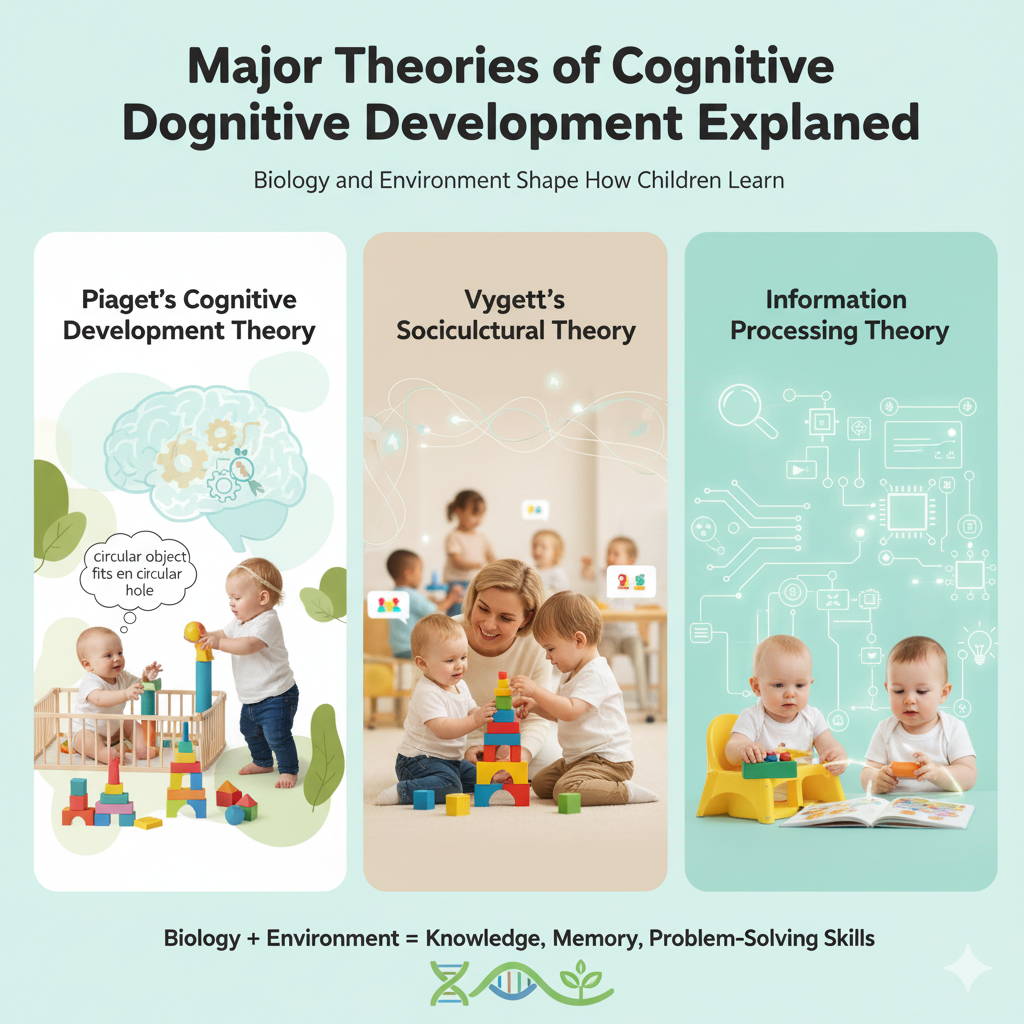
Understanding how babies learn and think has long been a focus of developmental psychology. Several major theories help explain the patterns of growth we see in infancy and early childhood.
The most widely discussed are Piaget’s Cognitive Development Theory, Vygotsky’s Sociocultural Theory, and the Information Processing Theory. Together, they show that both biology and environment shape how children gain knowledge, build memory, and develop problem-solving skills.
Piaget’s Cognitive Development Theory
Swiss psychologist Jean Piaget introduced the Piaget Cognitive Development Theory, one of the most influential frameworks in child psychology. According to this Cognitive developmental theory, children actively build knowledge through experience, moving through predictable stages.
The Sensorimotor Stage (birth to 2 years) is where babies begin their learning journey. Piaget identified six substages within this period:
- Reflexive behaviors (0–1 month), actions such as sucking or grasping.
- Primary circular reactions (1–4 months), repeating actions that feel good, like thumb-sucking.
- Secondary circular reactions (4–8 months), exploring objects, such as shaking a rattle.
- Coordination of reactions (8–12 months), combining actions to achieve goals.
- Tertiary circular reactions (12–18 months), experimenting with variations in behavior.
- Early symbolic thought (18–24 months), beginning of imagination and pretend play.
A key achievement during this stage is object permanence. Parents often ask, what age do babies understand object permanence? It typically develops around 6–9 months, when infants realize that objects continue to exist even when they are out of sight.
Piaget also described how children build schemas, or mental models. When new information fits what they already know, they use assimilation. When it does not, they adjust their schemas through accommodation. These processes drive intellectual growth. For a detailed breakdown of Piaget’s stages, see our guide on Stages of Cognitive Development.
Vygotsky’s Sociocultural Theory
Russian psychologist Lev Vygotsky emphasized the importance of relationships and culture in learning. His sociocultural theory highlights that children develop best with support from more experienced people.
The central concept is the Zone of Proximal Development (ZPD). This refers to the gap between what a child can do independently and what they can achieve with guidance. When parents, caregivers, or teachers provide the right level of help, a method called scaffolding, children stretch their abilities and grow faster.
Guided play and responsive interaction give babies a foundation for later skills such as cooperation and sharing. These ideas connect closely to Toddler Behavior and Emotional Growth, where social learning takes center stage.
Parental interaction and cognitive growth are not just helpful but essential. Simple acts like narrating daily routines, asking questions, or modeling problem-solving give babies the tools to expand their thinking within the ZPD.
Information Processing Theory
Unlike stage-based theories, the Information Processing Theory looks at the brain as a system that handles input, storage, and retrieval of information. This approach focuses on the specific mental processes that babies use as they develop.
Two key areas are infant memory development and the growth of attention span. Memory allows babies to recognize familiar faces or anticipate routines, while attention helps them focus on tasks, even if only briefly. These two abilities interact, but researchers note clear differences between memory vs attention in infants. For example, a baby may recognize a toy (memory) but still become easily distracted (attention).
This perspective helps explain how improvements in memory and attention over time set the stage for more complex problem-solving and learning strategies in later childhood.
Red Flags: Signs of Infant Cognitive Delay
The table below highlights concerns to watch for at different stages. While every child develops at their own pace, these signs may indicate the need for closer attention or professional advice.
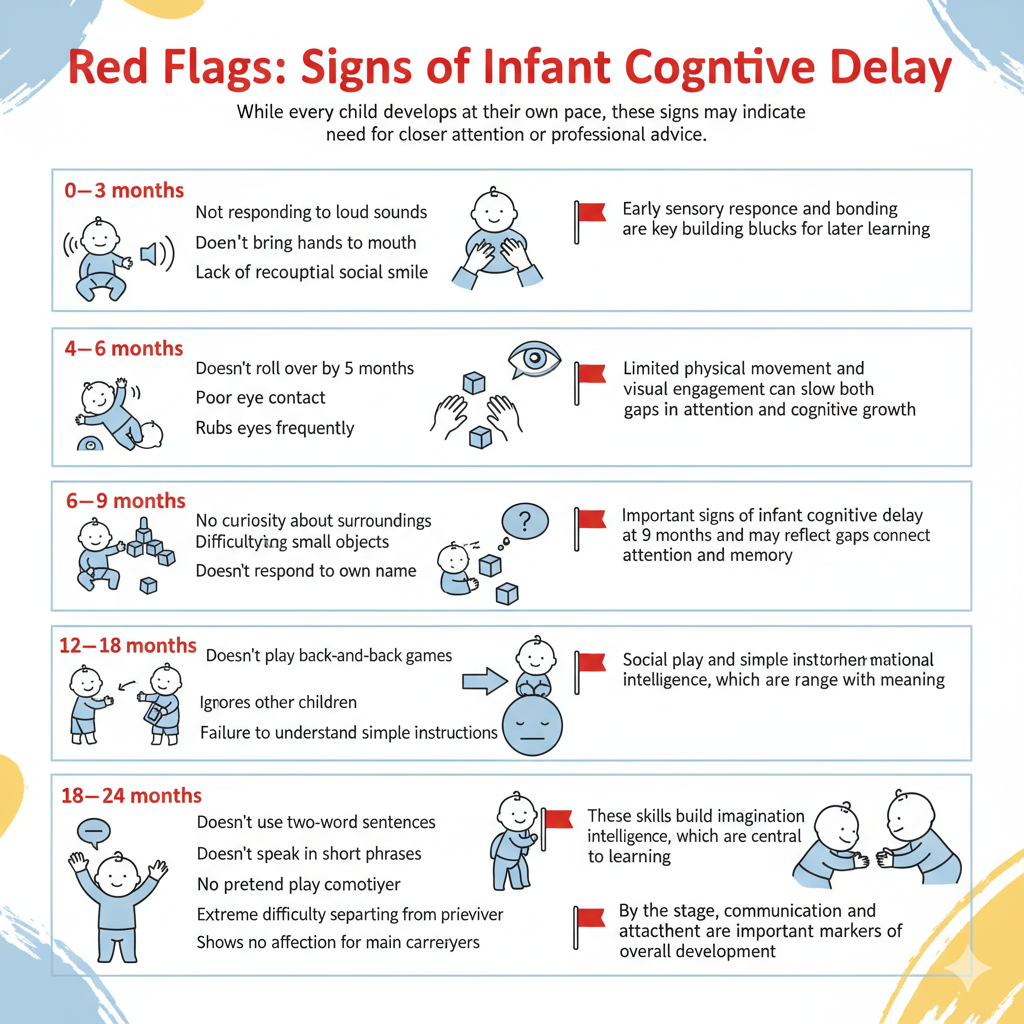
👉 If you notice more than one of these concerns, especially combined with a lack of interest in caregivers or surroundings, it is best to talk with a pediatrician. Early support can help address issues before they become bigger challenges. For detailed strategies, see our article on Early Intervention for Developmental Delays.
How to Stimulate Baby’s Brain at Home?
Parents often wonder how to stimulate baby brain development at home without overwhelming their little one. Many answers come down to the basics, such as feeding, bonding, and routines — all of which are covered in Newborn Baby Care Fundamentals
These simple baby brain stimulation activities build memory, attention, and problem-solving skills while making family time more fun. Below are proven activity ideas for baby attention span and early learning.
Talk and Narrate Throughout the Day
Conversation is one of the most powerful tools for early brain growth. Describe what you are doing as you cook, dress, or play with your baby. This constant language exposure strengthens neural pathways, builds vocabulary, and connects words to meaning.
Research shows that responsive caregiving, where parents respond to a baby’s coos or gestures, boosts both cognitive and emotional development.
Play Peek-a-Boo and Hide-and-Find Games
Simple games like peek-a-boo are more than fun; they help babies understand that objects and people exist even when out of sight. This concept, called object permanence, usually develops around 6 to 9 months and is a key step in memory development.
Hide a toy under a blanket and let your baby find it. These playful moments build problem-solving skills while keeping them entertained.
Use High-Contrast Toys and Books
Newborns see best when objects are bold and simple. High contrast toys baby sees, such as black-and-white books or brightly patterned rattles, capture attention and provide rich visual stimulation.
As eyesight sharpens, gradually introduce toys with more colors and details. These activities strengthen focus and recognition, which later support reading and attention span.
Create Simple Patterns and Routines
Babies thrive on repetition. A predictable routine, like a nightly lullaby or daily walk, helps them recognize patterns and develop early logical thinking. Repeating simple games, such as clapping or stacking blocks, reinforces learning by showing that actions have consistent outcomes.
These routines give babies a sense of security while also training their brain to expect and understand cause-and-effect.
Encourage Safe Exploration
Exploration is one of the most natural ways babies learn. Providing a safe environment where they can reach, crawl, and experiment helps them practice cause-and-effect learning. For example, dropping a toy and watching it fall teaches basic problem-solving.
This kind of sensory play fuels curiosity, strengthens motor skills, and supports deeper connections in the brain. Encouraging exploration builds confidence and lays the groundwork for independent learning in later years.
Babies learn through exploration, but safety always comes first. Creating a secure environment is essential, and resources like Home Safety and Proofing for Families can help you set up the right space.
Final Thoughts
Cognitive development is a journey, not a race. Every child follows their own path, and small differences in timing are usually part of healthy growth. What matters most is not perfection but consistency, love, and daily interaction. Talking, playing, and responding to your baby’s cues are the most powerful ways of supporting baby’s memory development and building strong thinking skills.
Remember that baby intellectual development goes hand in hand with other areas like language, motor skills, and emotional growth. To see the full picture of your child’s early progress, explore our guides on these related topics and discover practical ways to support each stage.
FAQs About Baby Cognitive Development
When does cognitive development begin?
Cognitive development starts at birth. Reflexes, sensory awareness, and early responses to sound and touch are the first signs of learning.
What are examples of cognitive skills?
Core skills include memory, attention, curiosity, problem-solving, and imitation. These grow stronger through play and interaction.
What’s the best activity for brain growth?
Talking and interactive play are the most effective. Responsive communication stimulates language, memory, and emotional connection.
How can cognitive development be supported?
Provide daily stimulation through play, conversation, reading, and safe exploration. Consistent caregiver interaction is the strongest foundation.
What is the role of cognitive development in learning?
It builds the ability to think, remember, and solve problems, which directly supports academic skills like reading, math, and reasoning.
What are the key aspects of cognitive development?
Attention span, memory, cause-and-effect understanding, problem-solving, and symbolic thought are central to early growth.
What are the theories of cognitive development?
The main theories are Piaget’s Cognitive Development Theory, Vygotsky’s Sociocultural Theory, and the Information Processing Theory. Each explains different parts of how children learn.
How does cognitive development impact daily life?
It influences how babies explore their surroundings, recognize caregivers, build routines, and learn social interaction. These skills form the basis for independence and learning in later years.
What age do babies recognize caregivers?
Most babies start recognizing their caregivers between 2 and 4 months, showing preference through smiles, eye contact, and comfort-seeking.
How do I know my baby is learning?
Look for signs like curiosity, repeating actions, recognizing familiar people, responding to voices, and trying to imitate gestures or sounds. These behaviors show active learning.
